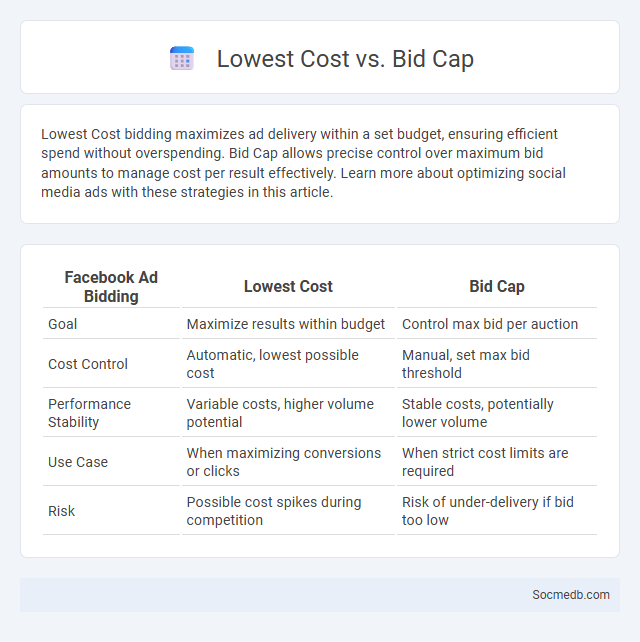
Photo illustration: Lowest Cost vs Bid Cap
Lowest Cost bidding maximizes ad delivery within a set budget, ensuring efficient spend without overspending. Bid Cap allows precise control over maximum bid amounts to manage cost per result effectively. Learn more about optimizing social media ads with these strategies in this article.
Table of Comparison
| Facebook Ad Bidding | Lowest Cost | Bid Cap |
|---|---|---|
| Goal | Maximize results within budget | Control max bid per auction |
| Cost Control | Automatic, lowest possible cost | Manual, set max bid threshold |
| Performance Stability | Variable costs, higher volume potential | Stable costs, potentially lower volume |
| Use Case | When maximizing conversions or clicks | When strict cost limits are required |
| Risk | Possible cost spikes during competition | Risk of under-delivery if bid too low |
Understanding Facebook Ads Bidding Strategies
Facebook Ads bidding strategies determine how your budget is allocated to maximize ad performance and reach. Your bid can be set manually or automatically, influencing the cost per result based on competition and campaign objectives. Understanding the difference between lowest cost, cost cap, and bid cap options helps optimize your ad spend and achieve desired outcomes.
What is Lowest Cost Bidding?
Lowest Cost Bidding is a social media advertising strategy designed to maximize Your campaign results by spending the least amount possible per desired action, such as clicks or conversions. This method allows platforms like Facebook and Instagram to dynamically optimize ad delivery to achieve the best outcomes within Your specified budget constraints. Leveraging algorithms that prioritize cost efficiency, Lowest Cost Bidding ensures You receive the highest return on investment by targeting the most relevant audience segments at minimal expense.
How Bid Cap Works in Facebook Ads
Bid Cap in Facebook Ads allows you to set a maximum bid for your ad auctions, ensuring you don't exceed your desired cost per result while competing effectively. This strategy gives you greater control over your ad spend by capping bids at a specific amount, aligning costs with your campaign goals and budget constraints. Understanding how Bid Cap works enables you to optimize your Facebook Ads for cost efficiency without sacrificing ad delivery or performance.
The Mechanics of the Facebook Ad Auction
Facebook ad auction determines which ads appear by evaluating your bid, estimated action rates, and ad quality to maximize user relevance and platform revenue. Your ad's success depends on these factors working synergistically to beat competitors in real-time bidding while delivering valuable experiences to users. Optimizing your campaign with targeted bids and engaging creatives enhances your chances of winning auctions and achieving desired outcomes.
Lowest Cost vs Bid Cap: Key Differences
Lowest Cost bidding on social media ad platforms automatically optimizes your budget to get the maximum results without a set bid limit, ideal for broad reach and efficiency. Bid Cap allows advertisers to set a maximum bid for ad placements, giving greater control over cost per action but potentially limiting delivery and scale. Choosing between Lowest Cost and Bid Cap depends on balancing efficiency and cost control based on campaign goals and competitive market conditions.
Pros and Cons of Lowest Cost Bidding
Lowest cost bidding on social media campaigns maximizes budget efficiency by automatically adjusting bids to get the most results for the set budget, ideal for advertisers seeking volume-driven conversions at minimal expense. However, this strategy risks overspending on low-quality clicks or impressions, potentially reducing ROI if the algorithm prioritizes quantity over engagement or relevance. Careful monitoring and optimization are essential to balance cost savings with campaign effectiveness and target audience accuracy.
Benefits and Limitations of Bid Cap Strategy
The Bid Cap strategy in social media advertising allows you to control your maximum cost per action, optimizing budget efficiency and preventing overspending on campaigns. This approach benefits advertisers by ensuring predictable costs and improving return on ad spend, particularly in highly competitive markets. Limitations include potentially reduced ad delivery and reach if the bid cap is set too low, which can limit campaign performance and audience engagement.
How the Ad Auction Determines Your Reach
The ad auction system on platforms like Facebook and Instagram assesses factors such as bid amount, ad quality, and estimated action rates to determine which ads get shown and how often. High-quality ads that resonate with the target audience and have competitive bids increase the likelihood of winning the auction, thereby expanding reach. This algorithm prioritizes user experience by balancing advertiser value with ad relevance, ensuring optimal engagement.
When to Use Lowest Cost or Bid Cap
Use Lowest Cost bidding on social media campaigns when aiming to maximize the number of conversions within a set budget, especially for broad audience targeting and brand awareness objectives. Choose Bid Cap bidding when controlling cost per action is critical, such as in competitive auction environments or when targeting specific, high-value conversions. Selecting the optimal strategy depends on balancing cost efficiency with campaign goals like lead generation or app installs.
Optimizing Campaigns for Maximum Results
Optimizing social media campaigns involves leveraging data analytics to target the right audience segments, enhance engagement rates, and improve conversion metrics. Employing A/B testing on content variations and posting times refines messaging and maximizes reach across platforms. Utilizing advanced tools like Facebook Ads Manager and Google Analytics ensures precise tracking and real-time adjustments to boost return on investment (ROI).
 socmedb.com
socmedb.com